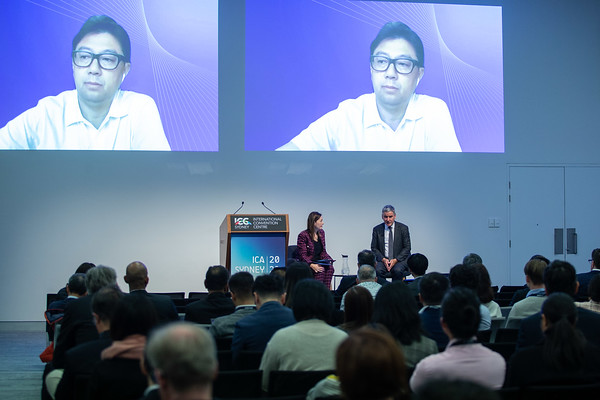
Asian Financial Services – Incumbents and Innovators
Brought together to discuss the shape of Asia’s Financial Services sector, Jonathan Larsen from Ping An and Alex Kimura from McKinsey talked incumbents, innovators and trillion dollar opportunities.
Ping An’s Chief Innovation Officer, Jonathan Larsen, opened this session by referencing technology’s deep impact on our society. In everything we do, from ordering a coffee to buying a plane ticket, we are seeing the fruits of digitisation, miniaturisation and the cloud. Artificial intelligence and machine learning are becoming parts of our daily life.

Yet Jonathan believes we are yet to see a technological revolution in financial services in Asia and around the world. In his view, the insurance industry is largely what it was 20 years ago, despite all the excitement about fintech and insurtech.
The enthusiasm for insurtech was particularly in evident in the B2C sector, where businesses play with innovation elements around user experience, convenience and pricing. While the percentage of consumers who bought insurance digitally in the past year is under 10% in France, Spain and Italy, it’s reached 49% in the UK. This is an impressive number links a high-tech front end to a very low-tech back end in the motor insurance sector.
The relative underperformance of insurtech is reflected in their sharemarket returns. Companies such as Go Health, Bright Health Group and Hippo are all down over 90% since their IPO.
Safe inside their moats?

Fintech and insurtech businesses have struggled to find business models that worked. Incumbents have benefitted from their strengths in brand, customer base, access to capital and relationships with regulators. These have effectively acted as moats. Larsen believes no significant financial services company has been disrupted by a fintech or insurtech in the way that occurred in sectors such as media and entertainment.
Yet the global insurance industry has no room for complacency. In the calendar year 2022, the weighted average return on equity from insurance businesses was 8.5% as opposed to the S&P average of 16.4%. “This is an industry running on legacy technology using legacy process and providing legacy customer experiences,” says Jonathan.
The good news is that there are vast insurance-related opportunities the insurance industry could address to meet the needs of its customers and capture growth. Larsen has identified five ‘gaps’ he believes add up to a potential opportunity worth $3 to $4 trillion.
Mining the gaps
These issues include the retirement gap, a healthcare gap, under insurance in life and disability insurance, insurance addressing climate change and the need to bring surplus capital into the insurance sector.
Larsen says capturing these opportunities requires incumbents to improve their operational and capital efficiency and to equip themselves with advanced technologies that provide a genuinely transformative future for the insurance industry and its customers in Asia and around the world.
McKinsey’s Alex Kimura brought a more bottom-up view to the potential of Asia’s financial services businesses. He noted that within the next two years, 30% of the US$8 trillion in global premiums written each year will come from Asia.

Alex then discussed his perspective on the epochal social and demographic challenges facing Asia and the opportunity this represented for businesses prepared to invest and innovate in those markets.
According to the Swiss Re Institute, there is an $83 trillion mortality gap in Asia[1]. There is a lack of longevity cover, cover which could be crucial as we will soon see a 50% increase in the population aged over 65 in markets like Singapore, China and Thailand.
Kimura also highlighted the incredibly low level of insurance penetration (under 3%) in economies such as Vietnam, the Philippines and Indonesia.
Kimura then introduced the audience to some of Asia’s most innovative and fastest-growing financial services businesses, including Indonesian company Pasar Polis. The company’s innovative online platform sold over 600 million policies in 2019 and, thanks to AI and machine learning technologies, it can process some 80% of its claims online in 18 seconds.
In India, Policy Bazaar has become the country’s largest online marketplace. There were 126 million visits to its website in 2021 and, through innovative technologies such as text to speech, it has grown its motor insurance offering dramatically.
In China, where nearly 15% of the population are older than 65, Taikang is building a retirement care ecosystem that features retirement insurance and converts those insurance customers into residents at Taikang aged-care communities, where the company completes the circle by providing health and wellness services.
Concluding this session, both presenters agreed that due to the scale of the Asian financial services opportunity, the demand for actuaries in Asia will continue to grow as actuarial skills in product management and development, pricing and data science will be crucial to implementing great economic and social change.
Missed out on this session? All ICA2023 content is now available via the Actuaries Institute’s CPD. Watch now.
References
[1] Swiss Re Institute Closing Asia’s Mortality Protection Gap, Swiss Re. Available at: https://www.swissre.com/institute/research/topics-and-risk-dialogues/economy-and-insurance-outlook/asia-mortality-protection-gap-report.html
CPD: Actuaries Institute Members can claim two CPD points for every hour of reading articles on Actuaries Digital.






